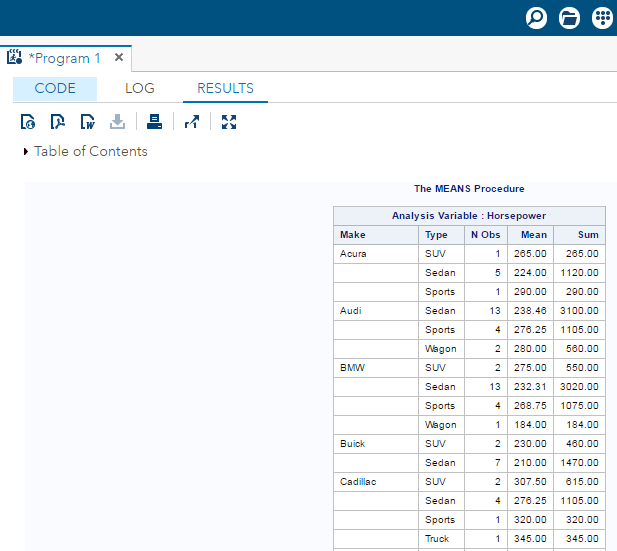

If anyone has any idea how to incorporate bootstrapping code, I'd REALLY appreciate it. If anyone has any idea how to incorporate bootstrapping code, I'd REALLY appreciate it.I'm at a total loss! The query fetches some of the columns of the data set. In The below program queries the SAS data set named CARS available in the library SASHELP. In this module you get an overview of this course and set up the data you need for practices and. The Read operation in SQL involves writing SQL SELECT queries to read the data from the tables. Video created by SAS for the course 'Preparing for the SAS Programming Certification Exam '.

Model outcome (event = '1') = age Charlson warfarin sex1/ When the above code is executed we get the following result. Here's the code so far (without bootstrapping): What I'm hoping is to run about 100 different bootstrap samples of 1000 observations each, do univariate regression on each for the variables 'age', 'Charlson', 'warfarin' and 'sex1' and then do a logistic regression on the variables that are significant based on the bootstrapping (using 'outcome' as the dependent variable) In the example below, we use the STARTPAGE=NO option to insert only new pages when the current page is full.Has anyone ever done bootstrapping on a dataset for which you were planning to do a regression analysis? My dataset is pretty small so I'd like to ensure stability of the predictors in my model but I'm not sure about how to write the code for this. BYGROUP: SAS inserts a new page after each BY-group.
Writing sas code full#
It only creates a page if the page is full or a new page is requested with STARTPAGE=NOW. NO: SAS doesn’t insert a new page after each procedure.However, the same concept of writing a raw data file using FILE and PUT statements can be applied to write a SAS program. SAS creates a new page after each procedure. Step 2: Writing Dynamic Code to Read Raw Data - Using DATA NULL A lot of programmers use DATA NULL for writing custom reports or raw data files. The STARTPAGE-option has 5 possible values: The STARTPAGE=-option is part of the ODS statement and can be used multiple times while generating a PDF. The code interpreter built into SAS ignores the comments and will not process them as SAS statements. Comments in a SAS program are essentially notes that you write into the program to remind yourself (and inform others) what the code is doing.
Writing sas code pdf#
You need the STARTPAGE=-option, to control page breaks in PDF files that contain SAS output. : Learn Data Science Using SAS Studio: A Quick-Start Guide: Engy Fouda: Apress: 2020: PDF, EPUB: 226: 22 Mb: EnglishDo you want to create data. SAS comments can help you avoid problems and headaches such as these. So, how can you avoid page breaks in PDFs generated by SAS? The Scoring Code pane in the code editor enables you to write Python score code that can be registered to SAS Model Manager for scoring new observations. Here you will find the code SAS has created automatically. However, if you are interested in the SAS code, you can check the Code tab. This can cause your PDF to be very long and to have a lot of unused paper. Examine the SAS Code (Optionally) As the steps above show, you don’t need to write one line of code to run this simple linear regression.

You may need to format the variables in your dataset the same way to reproduce results presented in the tutorial. These programs use variable formats listed in the Tutorial Formats page. When you create a PDF with the Output Delivery System, then there is (by default) a page break after each SAS procedure. Program code used in this tutorial follow procedures available in SAS 9.2, SUDAAN 9.0 or SUDAAN 8.0, and Stata/SE 10.0.


 0 kommentar(er)
0 kommentar(er)
